Best Mylar Bags for Food Storage
This post may contain affiliate links. Read my full disclosure here.
With more people getting into long term food storage, we’ve been getting a lot of questions about the best Mylar bags for food storage, and how to use them. We’ll walk you through some of the most common questions, so you can keep your food storage in good condition.
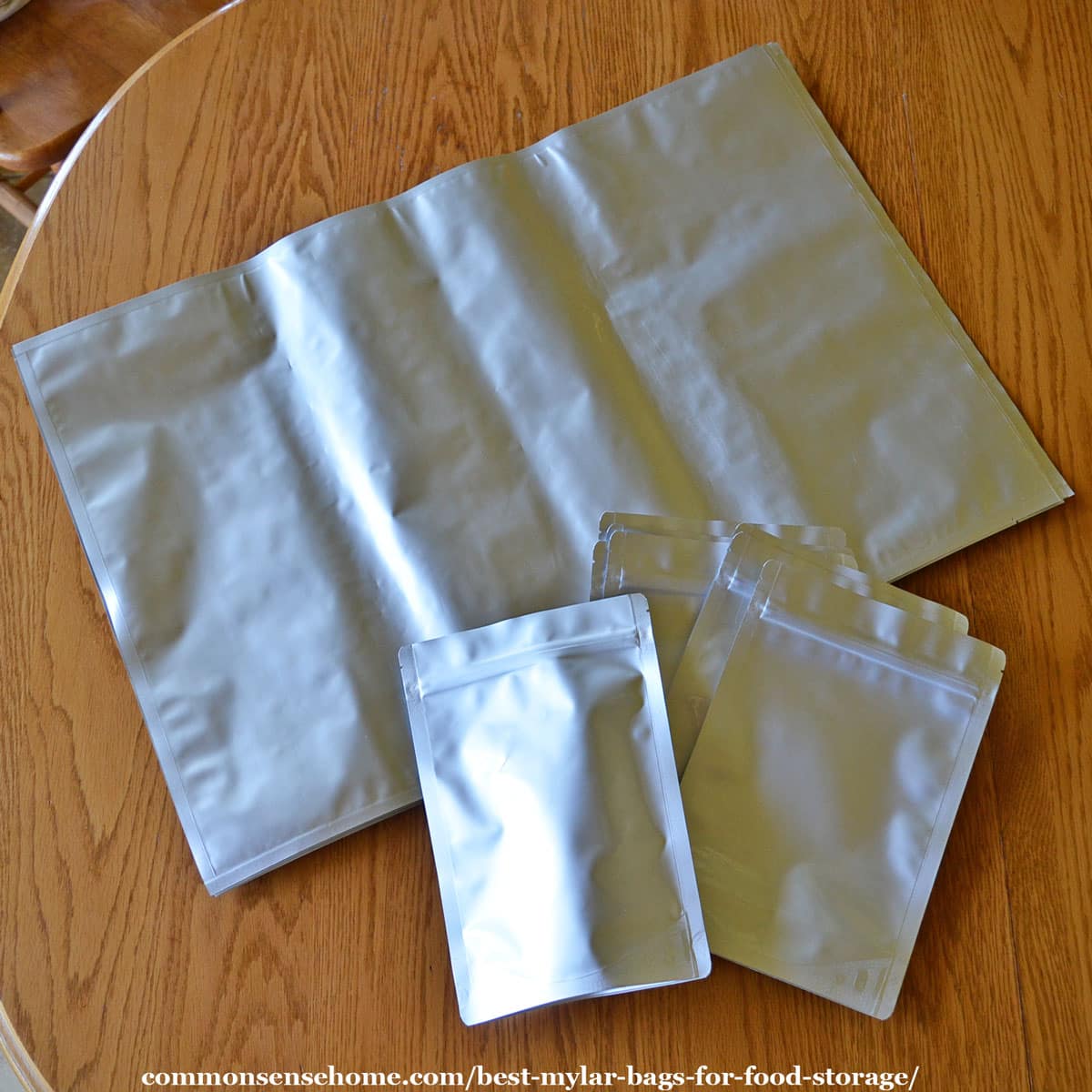
What is Mylar?
Mylar bags are effectively flexible metal bags, with a plastic base and an aluminum foil layer. The material is similar to a Mylar balloon, but the bags you want for food storage are thicker and more durable.
People choose Mylar bags for long term food storage for several reasons.
These bags:
- Last many years
- Keep the air and moisture out
- Protect the contents from light
- Flex and bend without breaking (impact resistant)
- Are lightweight
- Provide protection from insects
What Mylar bags should I buy for food storage, and what else do I need to use them?
Choose 5mil to 7mil thick Mylar bags for long term food storage. Mylar needs to be heat sealed, so you also need a sealer. We add oxygen absorbers, and sometimes moisture absorbers, to extend shelf life. Like all food storage, make sure to date and label your bags.
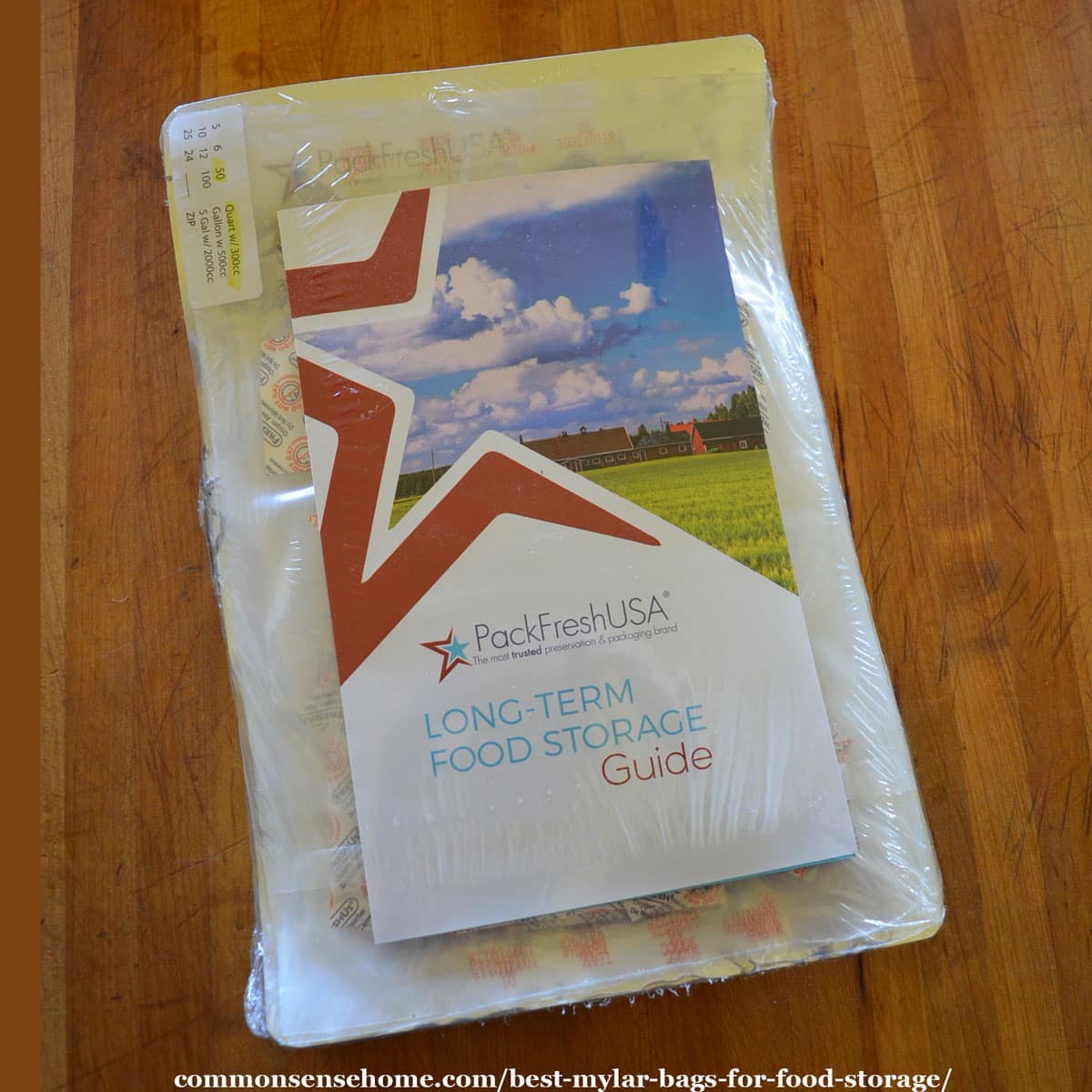
Quart Size Mylar Bags
We use quart Mylar bags for meals and assorted food. Each tray of our Harvest Right freeze dryer holds around a quart, so we can usually store the contents from one tray in one bag.
Our favorite bags so far are PackFreshUSA One Quart Mylar Bags. If Packfresh is out of stock, or you want thicker Mylar, the combo of ProPremium 50 Mylar Bags 1 quart and the FreshUS 300cc Oxygen Absorbers is a good alternative.
A quart bag holds around 4 cups, which is enough for a meal for 4 sedentary people or 2 active people. For ingredients like spices, we sometimes cut the quart bags in half.
Gallon Size Mylar Bags
A gusseted gallon size mylar bag will hold approximately the same amount as a #10 food storage can. These are those large cans you see in the food service section of a grocery store with items like peaches, tomato sauce, etc.
It can hold approximately 16 cups of freeze dried food. This size is good for 6-8 meal-sized servings.
Five Gallon Mylar Bags
We use 5 gallon Mylar bags to store dry food in 5 gallon buckets. Commonly stored bulk foods include rice, dry beans, flour, salt, sugar, wheat berries, and other dry goods.
We recommend PackFreshUSA 5 Gallon Mylar Bags or 15x 5 Gallon Wallaby Mylar Bag Bundle.
To keep food fresher, we often divide a 5 gallon bag in two, then pack each half with 10 pounds of food. That way, when we open a bag, we know we’ll be able to use it all before the food spoils. Using several 1-gallon Mylar bags in another option.
Be careful to buy from reputable sources. High demand is luring scammers into offering substandard product or bait and switch product listings.
Scams include claiming ten 10 packs and only delivering a single 10 pack, or claiming 7mil and delivering 4mil.
Mylar Bag Sealer, Oxygen Absorbers, and Labels
A Mylar bag sealer uses heat to melt the bag closed. (Remember to add the Oxygen Absorber (O2 Absorber) and/or moisture absorber(s) before you seal the bag.)
There are impulse sealers designed specifically for bag sealing, or you can use a clothes iron or hair straightening iron.
Most vacuum sealers will also seal Mylar bags, but they can’t vacuum seal Mylar without some adjustments. The surface of the Mylar is smooth, not textured like vacuum seal bags, so it closes right away and won’t let the air out of the bag.
If you place a one inch strip of a vacuum seal in the opening of a Mylar bag before sealing, it allows air to get out. There are lots of videos on tricks using a vacuum sealer or the Harvest Right freeze dryer to vacuum seal Mylar bags. We use O2 absorbers because it’s faster and easier.
For dry foods, we only use an oxygen absorber. If we think there’s a chance that a food may not be completely dry, or it has a high fat content, we add an O2 absorber and a moisture absorber.
We write the date and contents on the outside of bags with a Sharpie Marker, but you can purchase nice labels if you prefer,
Buckets
If you’re storing food in one gallon or five gallon buckets, I highly recommend a bucket opener. They are inexpensive, and make opening buckets much easier.
- 5 Gallon Paint Can Lid Opener
- Works Great For 5-Gallon Paint Cans
- Easy To Use And Stores Easily With The Hand Hole On Handle
- Brand Name: Linzer
What type of Quart Mylar Bag should I buy?
Our favorite brand so far is PackFreshUSA. I like the flat bags without gussets or zippers best, as they seem a little roomier. We usually use an entire bag at one time, or repack any leftovers in a Mason jar, so we don’t need the zipper top.
You can use straight, rounded or gusset Mylar bags for freeze dried foods. Zipper op Mylar is good for spices, salt, sugar etc. – foods where you won’t use the entire package at one time.
Skip the bags with the little see through windows for your long term storage, since they let light in. They’re great for gift giving or short term storage.
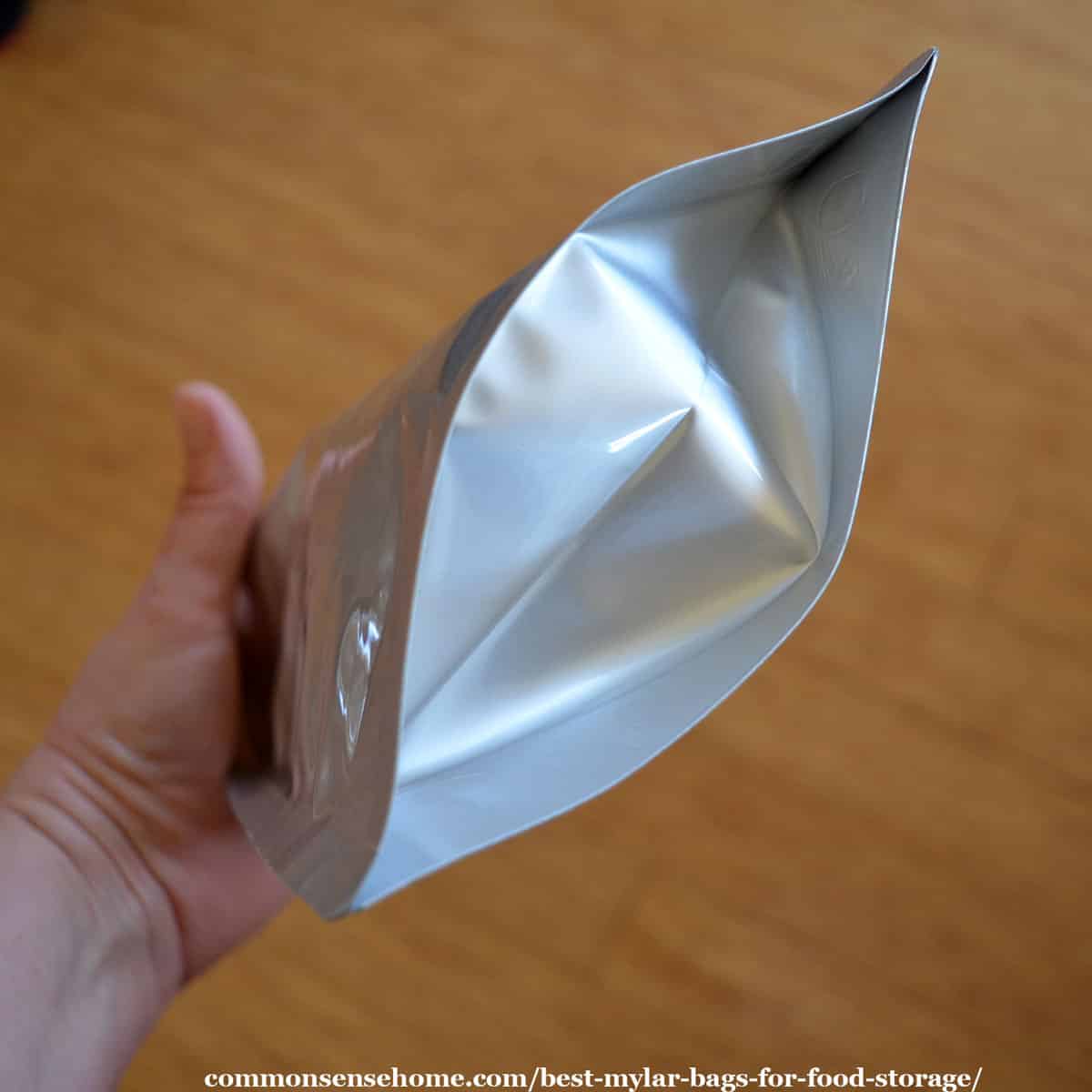
Would you like to save this?
Which O2 absorbers should I buy?
We usually purchase the Mylar bags and oxygen absorbers in a combination pack. For instance, 50 quarts bags and five 10 packs of oxygen absorbers.
When you buy oxygen absorbers in bulk, it’s a good idea to purchase ten packs of 10 absorbers instead of one pack of 100. That way when you open them up, you’re not exposing all 100 to the air.
Each Mylar bag needs at least the following:
- 5 gallon Mylar bag = 2000cc O2 absorber
- 1 gallon Mylar bag = 300cc O2 absorber
- 1 quart Mylar bag or mason jar = 100cc O2 absorber
Don’t use oxygen absorbers with sugar, salt, baking soda, or baking powder, as the O2 absorbers can make them stiff and difficult to use.
How to Use Mylar bags to Store Food
Prepare the food you want to store, along with the bags, heat sealer, O2 absorbers, and labels/permanent marker. It’s best to set up things assembly line fashion, propping up your bags for filling and sealing.
Purchase bulk dried foods like rice, beans, salt, sugar or flour. Home freeze dried foods or dehydrated foods also store well in Mylar. Make sure the moisture content is below 10% to avoid the risk of botulism. Dehydrated and freeze dried foods should be crisp or brittle for long term storage.
Remember, the bags keep out air, moisture, and insects, but not rodents. For long term storage, place the bags inside a tougher container, like a 5 gallon bucket.
Label your bags before you start filling with the contents and date. It’s much easier to write on bags when they are flat.
Place food in the bag, but leave a couple of inches near the top so the bag ends can close. Fill all the bags, taking time to shake down the food and wipe the opening clean.
Once all the bags are filled and clean, add an O2 absorber and/or moisture absorber and seal promptly with a heat sealer. Store any unused O2 absorber and/or moisture absorbers in tightly sealed mason jars.
In the video below, Laurie and Duncan demonstrate how to store rice in Mylar and in mason jars.
Pack your bags into their storage container, and don’t forget to date and label the container, too. If keeping a mix of items in one container (like a Rubbermaid tote), keep an inventory slip at the top of the container.
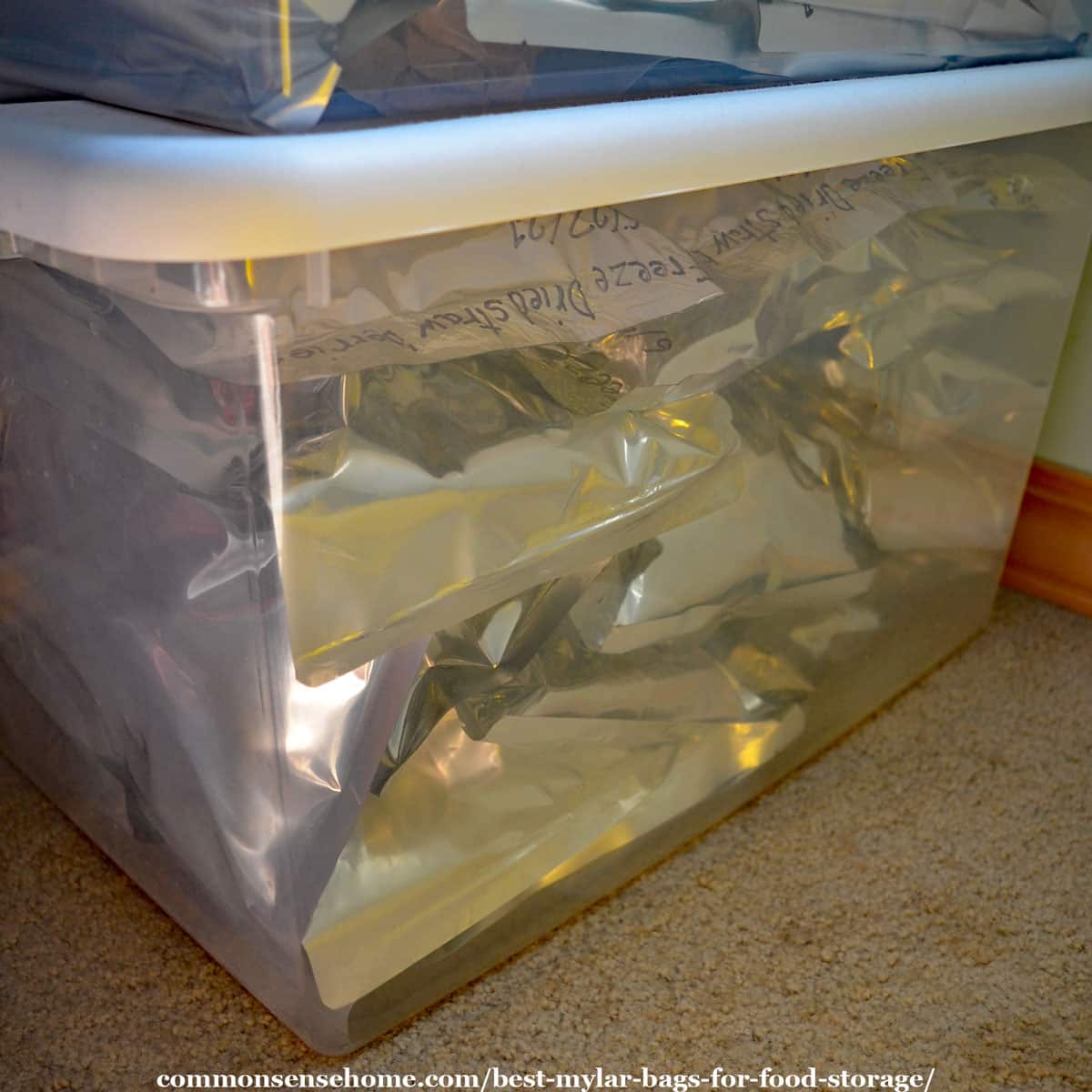
Questions and Answers for Mylar Bags, O2 Absorbers and Moisture Absorbers
How long will food in Mylar bags last?
Foods stored in Mylar bags can keep from a few months to 30+ years. The higher the FAT or OIL content of the stored foods, the shorter the storage life.
Dry rice with an O2 absorber in properly sealed Mylar will last 25+ years. Don’t store wet foods in Mylar for any extended period (more than a few days).
Storing salt or sugar in Mylar may seem like overkill, but it keeps moisture out, which reduces the chances of bad smells/flavors getting into the salt or sugar. For salt and sugar, we use moisture absorbers for long term storage.
If the Mylar bags start bulging, don’t eat the food inside, as this is a sign of spoilage.
Why are thick mylar bags better?
Mylar thickness is measured in mil, which is one-thousandth of an inch, or 0.001 inch. For food storage, select Mylar 5mil to 7mil Mylar. Be careful with Mylar over 7mil thick, which can have edges sharp enough to cut your fingers.
Thicker Mylar is less likely to tear, and when sealed properly keeps oxygen out. Thinner Mylar can tear or be punctured more easily. Sometimes the metalized coating will come off of flimsy Mylar, leaving the food exposed to the light.
What should I do with leftover oxygen and moisture absorbers?
Store unused O2 and moisture absorbers in a tightly sealed container. We put them in the smallest canning jar that they fit in, and seal it as quickly as possible. Don’t store the absorbers together.

Can you store water in Mylar bags?
You can store water in Mylar, but we don’t recommend it. Get a 55 gallon drum or other container designed for long term water storage. It’ll be much easier to fill, and to rotate your storage.
See Emergency Water Storage and Filtration – What You Need to Know Before Emergencies Hit for more information.
Can you Reuse Mylar bags?
Yes. If the bag is intact and clean, you can reuse it. We reuse large 5gal bags for sugar, salt and other dry goods. The bags can pick up odors from food, so be sure to sniff test before reusing.
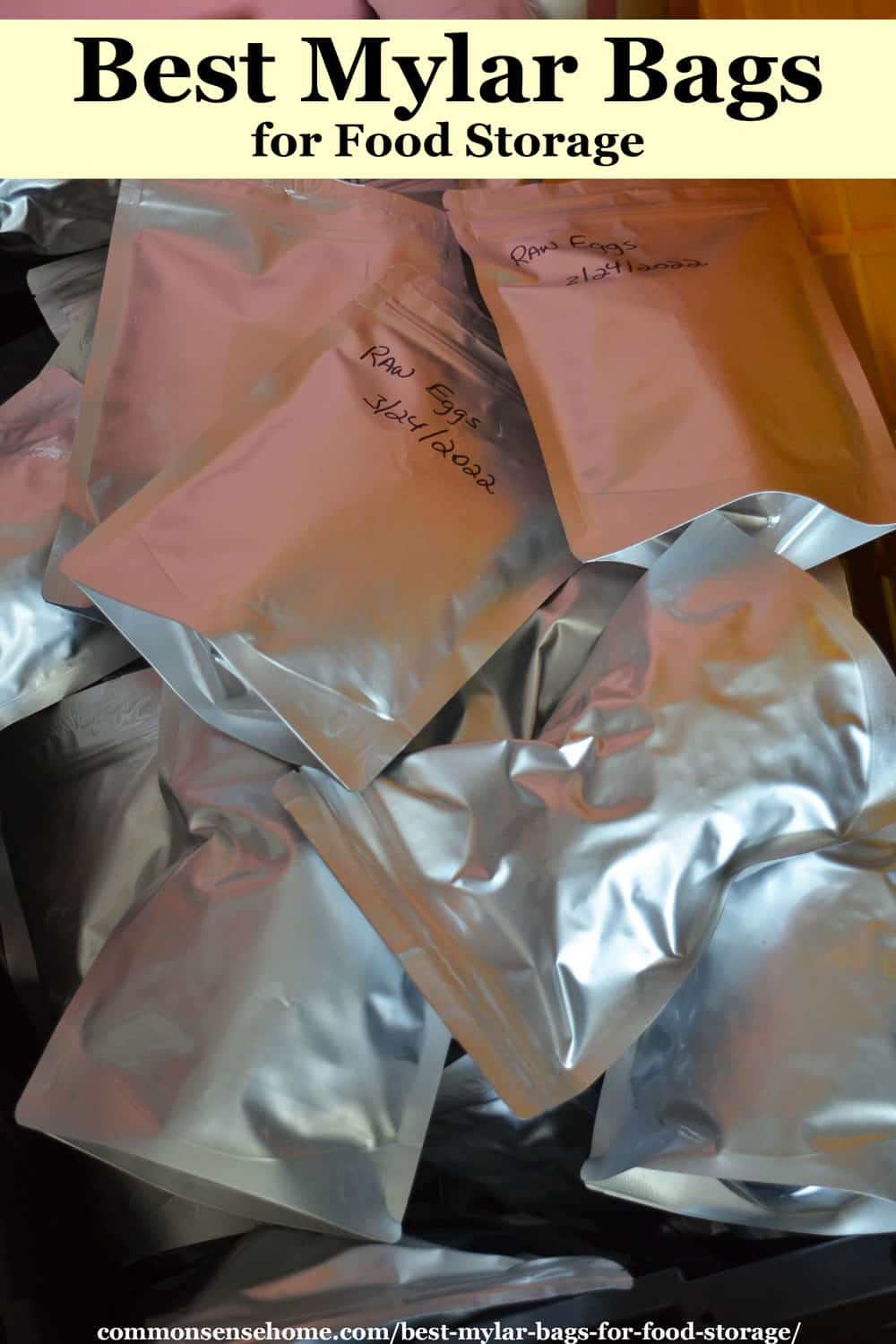
More Food Storage Information
We have dozens of food storage articles on the site, covering everything from home food preservation techniques to stocking on dry goods.
Best Non Perishable Foods (For Home Use or Donations)
Long Shelf Life Foods (with Printable PDF chart)

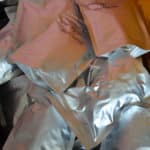



Thanks for this article. We typically have packed our processed harvest in glass, but the volume is starting to exceed practical storage considerations. We have a big pup who LOVES veggies, fresh or dried. He spends a lot of time indoors. He is well behaved, but still capable of pulling dumb stunts. How careful do we need to be with oxygen absorbers and moisture absorbers, which often pick up the aroma of the food they are stored with? And what can we do if pets (or little kids) take a bite out of them?
Lastly, can you suggest a commercial source of food grade storage buckets? To date, we have purchased used grocery store bakery buckets for a couple of bucks each, but of late they get snapped up pretty quickly, and are getting harder to find.
Ideally, keep an eye on the dog or child to prevent ingestion.
O2 absorbers – with a big dog, even if they manage to eat one, it shouldn’t cause a serious problem. You could give the dog (or child) milk of magnesia to reduce absorption of the iron. The risk is higher with smaller dogs. If a small dog eats a packet, watch for signs of distress, such as vomiting. Take small dogs to vet for assistance.
Silica moisture packets are non-toxic and should pass through the dog’s system. Make sure they stay hydrated.
Bakeries and other food prep places such as restaurants or even butchers where they get in bulk spices may have used buckets for sale. If you can’t find them used, amazon and other online retailers have food grade buckets for sale. Any place that sells preparedness supplies should have them. Some bulk food stores may also have them.
Do oxygen absorbers and moisture absorbers go bad? If so, how can you tell? Can I use the ones I’ve gotten in my vitamins? Can vitamins be stored in mylar bags? If so, How long will magnesium, D3, calcium, fish oil, last? Would it be helpful to put sunscreen in the bags? Thank you
Hi Cheryl.
Oxygen absorbers and moisture absorbers don’t “go bad” in the sense that they rot, but once exposed to air they do what they are designed to do – absorb oxygen or moisture. This happens via chemical reaction. Generally, it’s a one time use, one way chemical reaction, but in some cases, moisture absorbers can be dried and reused. I am not aware of any oxygen absorbers that can be “recharged” once their reaction is complete.
What does this mean for the user?
For you, this means that the oxygen and moisture absorbers you find included in purchased products have likely done the job they were intended to do, absorbing oxygen or moisture in the package. Like a single use battery that has exhausted its charge will no longer power a flashlight, these used absorbers will not help preserve additional foods or products.
There is usually not a visual indication/easy way to tell that they are used up. However, manufacturers have likely done the math and sized these absorbers to protect the product they are selling, and nothing more, to keep costs low.
For instance, a 100cc oxygen absorber is manufactured to chemically react with/absorb the oxygen of 100 cubic centimeters. It cannot physically absorb any more than that.
When purchasing oxygen absorbers and moisture absorbers for home food storage use, it’s important to place any that are not used immediately into small, airtight containers. If left exposed to air, they will react with the air, and be used up (unable to remove oxygen, unable to dry).
Many oxygen absorbers come with a small indicator patch that changes color when exposed to oxygen. If the patch is still the original color, the absorbers are still good. If it has changed color, your absorbers may have lost some or all of their ability to work due to exposure to air.
I get moisture absorbers that have color change granules inside of the pouches as an indicator. They can be recharged in the microwave. The instructions for recharging are on the package.
Most vitamins and supplements include their own absorbers in the airtight containers they are packaged in. Packing the bottles in a Mylar bag with additional absorbers is not likely to be of significant benefit. Shelf life of supplements will vary and should be labeled on the bottle.
Putting a bottle of sunscreen in a Mylar bag is not likely to increase its shelf life. For best shelf life, store in a cool, dry location out of direct sunlight.
Hi
I live in Canada and the company Wallaby does not deliver to Canada. Do you know of a mylar company that ships to Canada?
Also, how do you put say flour or sugar in a mason jar? Just add and then put an oxygen absorder? How long will this last about?
What is a moisture absorder used for as well?
Do you have an videos that you would recommend for me to view as this is my first time doing this?
Thank you
I haven’t researched Mylar in Canada, so I don’t know offhand where the best option to buy would be. I assume amazon would ship it, but butter pricing may be available elsewhere.
See “How to Store Sugar Long Term” and “How to Store Flour Long Term” for detailed storage instructions.
We have a video in the article “How to Store Rice Long Term” that demonstrates sealing Mylar and Mason jars.
With sugar and flour, the particle size is so fine that it can get sucked into a vacuum sealer, so it’s probably better to add and oxygen absorber to the flour container rather than vacuum sealing. Sugar could have a moisture absorber, but if it’s in an airtight container, it should be fine without it.
When after storing rice in 5 gal. Myler bag with ao,s , how do I keep opening and dipping into the bag without the ao,s losing their potency ?
Once you open a Mylar bag, your oxygen absorber will get overloaded with oxygen. That’s why I don’t generally recommend using 5 gallon bags for most people – unless they can use up an entire 5 gallon bucket of rice fairly quickly. Once we open a larger Mylar container, we’ll often divide into into smaller airtight containers (like mason jars). Then we open only one jar at a time when we need to use it and they are easy to reseal. You could also open up a larger Mylar container, scoop out what you will use for several months into an airtight container, add a fresh O2 absorber to the big Mylar bag and seal it up again.
Whatever container you store your Mylar in also offers some protection. Some people dump their rice straight into 5 gallon buckets. I’ve had bucket lids fail over time, so I like the extra protection of Mylar.
A helpful article as we are approaching dangerous economic times! A small correction: mylar bags are measured in mils, which aren’t the same as millimeters. A mil is one thousandth of an inch. (A 7mm-thick bag would be about a quarter of an inch.)
Questions: What is the advantage of mylar over standard vacuum sealer bags? Can you put mylar in the freezer and is there any advantage to doing so? Or is it mainly for long-term storage of dry goods?
I ask because I have a chamber vacuum sealer that is capable of sealing mylar.
Love your site.
Hi Melanie.
Thanks for catching that. Trying to do too many things at once and made a silly mistake.
Mylar is less permeable than standard vacuum sealer bags. Before we started using Mylar more regularly, I packed ten pound bags of sugar, in the bag, slipped inside a cut to size vacuum seal bag. After two years, that sugar had turned into a 10 pound sugar cube from moisture it absorbed in storage.
In contrast, sugar stored in Mylar for a similar amount of time is loose and easy to scoop and pour.
So vacuum seal bags are good, but Mylar is just a little bit better.
It’s fine to put Mylar in the freezer, if you have room. Typically Mylar is used for storing dry goods that are shelf stable, so we don’t normally bother with the freezer, since the freezer is filled with other items.
Colder temps act as a preservative, but alternating freezing and thawing is not recommended. I think the only Mylar bags we have in the freezer right now are some freeze dried broth that had a little extra fat that should have been skimmed before drying.
I write the food name and date across only the very top of the bag, so all writing on the bag is cut off upon opening. Paper labels fall off after some time, so write directly on the bag with a Sharpie. Write with the Sharpie *after* sealing, to avoid getting any Sharpie ink coming off on your heat sealing device. I only use the bigger gallon bags so the bags are uniform size for easier storage – no quarts. After opening and removing what I need from a gallon bag, I will either reseal remaining contents in the same bag (and re-label bag) or put remaining contents into a half-gallon Mason jar and use my Foodsaver jar attachment to remove air from the jar. I only use 7mm mylar for pasta, because pasta has sharp edges that will cut thinner bags. Consider using mylar to package things in vehicles, like first aid items – they stay sealed and sanitary longer than using the Foodsaver-type plastic bags.